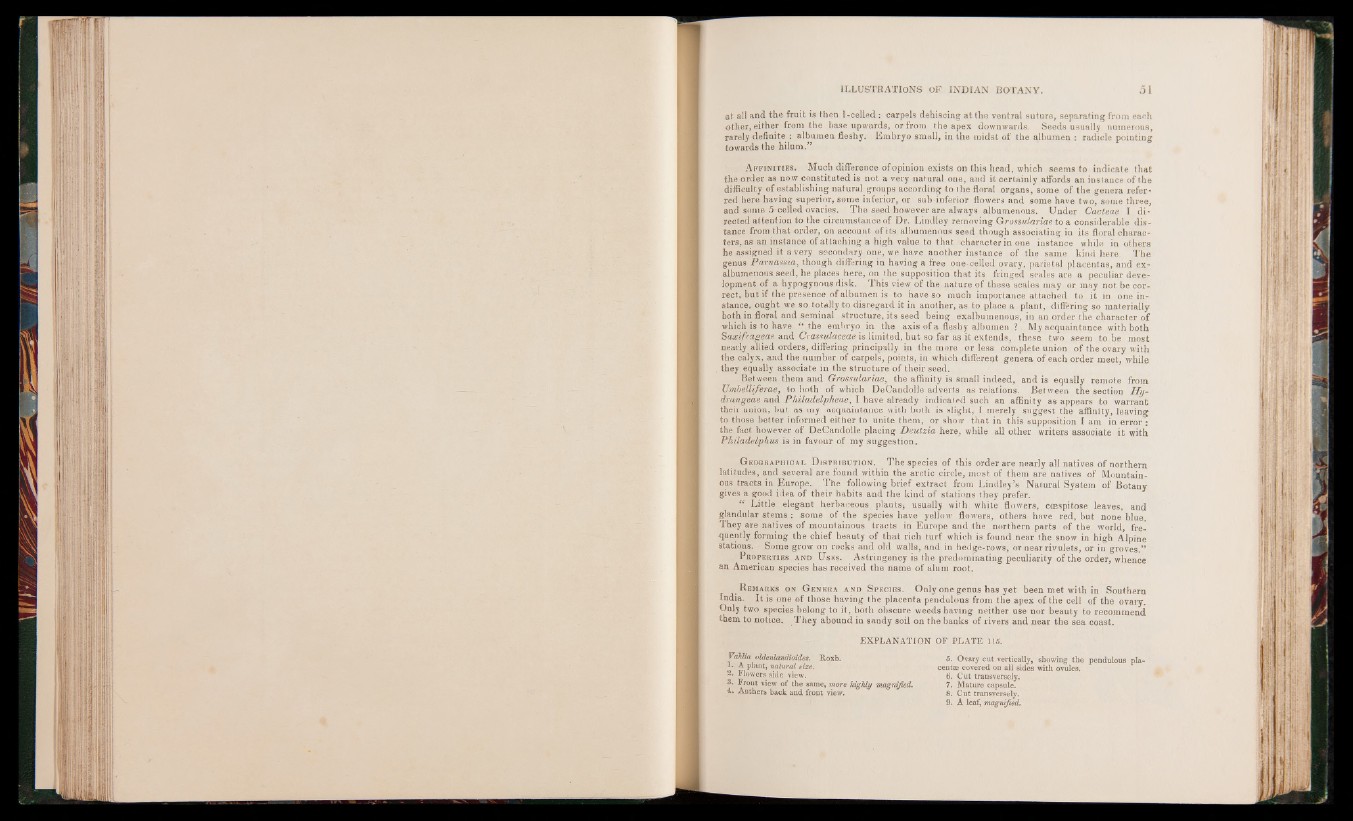
a t all and th e fru it is th en 1-celled : carpels d ehiscing a t th e v entral su tu re , sep ara tin g from each
o th e r, e ith e r from th e base upwards, o r from th e apex downwards. Seeds usually numerous,
rarely definite : album en fleshy. Em b ry o small, in th e m id st o f th e album en : rad icle pointing
towards the hilum .”
A f f in it ie s. Much difference of opinion exists on this head, which seems to indicate that
the order as now constituted is not a very natural one, and it certainly affords an instance of the
difficulty of establishing natural groups according to the floral organs, some of the genera referred
here having superior, some inferior, or sub-inferior flowers and some have two, some three,
and some 5 celled ovaries. The seed however are always albumenous. Under Cacteae I directed
attention to the circumstance of Dr. Lindley removing Gro-ssulariaeto a considerable distance
from that order, on account of its albumenous seed though associating in its floral characters,
as an instance of attaching a high value to that character in one instance while in others
he assigned it a very secondary one, we have another instance of the same kind here. The
genus Parnassia, though differing in having a free one-celled ovary, parietal placentas, and ex-
albumenous seed, he places here, on the supposition that its fringed scales are a peculiar development
of a hypogynous disk. This view of the nature of these scales may or may not be correct,
but if the presence of albumen is to have so much importance attached to it in one instance,
ought we so totally to disregard it in another, as to place a plant, differing so materially
both in floral and seminal structure, its seed being exalbumenous, in an order the character of
which is to have, " the embryo in the axis of a fleshy albumen ? My acquaintance with both
Saxifiragecte and Crasmlaceae is limited, but so far as it extends, these two seem to be most
nearly allied orders, differing principally in the more or less complete union of the ovary with
the calyx, and the number of carpels, points, in which different genera of each order meet, while
they equally associate in the structure of their seed.
Between them and Grossulariae, the affinity is small indeed, and is equally remote from
Umbelliferae, to both of which DeCandolle adverts as relations. Between the section Hy-
drangeae and Philadelpheae, I have already indicated such an affinity as appears to warrant
their union, but as my acquaintance with both is slight, I merely suggest the affinity, leaving
to those better informed either to unite them, or show that in this supposition I am in error :
the fact however of DeCandolle placing Dnutzia here, while all other writers associate it with
Pkiladelphits is in favour of my suggestion.
G eographical D istribution. The species of this order are nearly all natives of northern
latitudes, and several are found within the arctic circle, most of them are natives of Mountainous
tracts in Europe. The following brief extract from Lindley’s Natural System of Botany
gives a good idea of their habits and the kind of stations they prefer.
te Little elegant herbaceous plants, usually with white flowers, ccespitose leaves, and
glandular stems : some of the species have yellow flowers, others have red, but none blue.
They are natives of mountainous tracts in Europe and the northern parts of the world, frequently
forming the chief beauty of that rich turf which is found near the snow in high Alpine
stations. Some grow on rocks and old walls, and in hedge-rows, or near rivulets, or in groves.”
P roperties and U ses. Astringency is the predominating peculiarity of the order, whence
an American species has received the name of alum root.
R emarks on G enera and S pecies. Only one genus has yet been met with in Southern
India. It is one of those having the placenta pendulous from the apex of the cell of the ovary.
Only two species belong to it, both obscure weedshaving neither use nor beauty to recommend
them to notice. They abound in sandy soil on the banks of rivers and near the sea coast.
EXPLANATION OF PLATE 115.
Vdhlia oldenlandioides. Roxb.
1. A plant, natural size.
2. Flowers side view.
3. Front view of the same, more hig h ly magnified.
4. Anthers back and front view.
5. Ovary cut vertically, showing the pendulous placentae
covered on all sides with ovules.
6. Cut transversely.
7. Mature capsule.
8. Cut transversely.
9. A leaf, magnified.